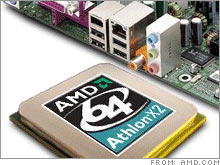|
How AMD made it a fight Better chips and an expanded product line put Intel on the defensive, says Fortune's David Kirkpatrick.
(FORTUNE Magazine) -- AMD is going after Intel in court, but it has already struck where it really hurts. After 20 years of unequivocal Intel supremacy, the market for x86 microprocessors has finally become - and for the foreseeable future will remain - a two-horse race. Says a very senior executive at a major PC company: "AMD is here to stay." Each of the top three PC makers is now a customer. AMD's biggest recent victory was landing Dell (Charts). The largest PC maker decided in May to end its exclusive relationship with Intel and put AMD's top-of-the-line Opteron processors into some servers. In early August, IBM (Charts) announced a new line of Opteron-based servers. AMD (Charts) now powers more than a quarter of all x86 servers worldwide. Hewlett-Packard (Charts) (the PC industry's No. 2) and Sun already sell AMD machines across their product lines. And Lenovo (Charts), the No. 3 PC maker worldwide, already a big AMD customer in China, plans to announce in August that it will start using AMD chips in a line of business desktop PCs for the U.S.
AMD CEO Hector Ruiz isn't declaring victory, though. While the company's share of x86 industry revenue has risen in three years from 8% to nearly 18%, according to Mercury Research, Ruiz says AMD needs 30% to stay healthy. But he is optimistic. "Now, of course, the big thing for us," he says, "is to get Michael [Dell] to go beyond servers." Don't think it couldn't happen. AMD has had surges in the past, but this one is different. It used to sell only fast processors for consumer desktop computers. Now it has chips for desktops, notebooks, and, most important, servers, the part of the business where profit margins are highest. According to PC semiconductor analyst Dean McCarron of Mercury Research, when AMD had only one strong product, Intel could easily beat it back with price cuts, funded with profits from its other businesses. McCarron says, "AMD used to be a weed to be chopped down every now and then. Now it is much deeper in the market." AMD broke out of its box partly by taking advantage of an Intel misstep. In the late 1990s Intel started pouring hundreds of millions of dollars into a new type of processor not based on x86 technology. Eventually called Itanium, the chip was aimed at high-end computing. It would process bits-the ones and zeroes of data-in chunks of 64 rather than 32, as x86 did. It also had the virtue of being uncopyable by AMD, which had won the right to use the x86 architecture in a series of court battles. But Itanium had a big disadvantage: Applications written for x86 ran on Itanium only in a clunky "emulation" mode. AMD saw that what customers wanted was a 64-bit version of x86 that could still run all the old applications, so it built one. When Ruiz became CEO in 2002, he oriented the entire company around the new AMD 64 architecture, developing products for every part of the market. He got a huge assist from Microsoft (Charts), which announced in 2003 that it would build a 64-bit version of Windows especially for AMD 64. By mid-2004, Intel was forced to copy AMD, announcing its own 64-bit version of x86, now the backbone of its entire product line. Meanwhile the Itanium business has remained lackluster. Sean Maloney, Intel's new executive vice president for sales and marketing, says, "We left the door open because we had been used to our competitor dropping the ball regularly. They picked up their game, so we picked up ours." Intel's financial results in the most recent quarter were abysmal (profits were less than half what they'd been a year earlier), but its product strategy is aggressive. In July it launched a range of new products it calls Core 2 Duo. Industry website CNET called it "the company's biggest product launch since Pentium in 1993." These two-processor 64-bit chips will go into desktops, notebooks, and servers. For now they outperform AMD's alternative products, though Intel's nemesis claims its own new designs will emerge shortly. Meanwhile, both companies are taking drastic steps to improve competitiveness. Intel CEO Paul Otellini said in July that the company would lay off 1,000 managers. He's also waging a price war and building inventory-AMD's stock has suffered as a result, dropping from $42 in March to below $20 in August. (In the same period Intel has slid from $20 to $17.) AMD in late July announced its biggest acquisition ever, of chipmaker ATI for $5.4 billion. Ruiz says that will let AMD enter new businesses, like consumer electronics. As the two chipmakers compete, they will speed innovation and cut prices. Expect your PC to get better and cheaper. _________________________ |
|

